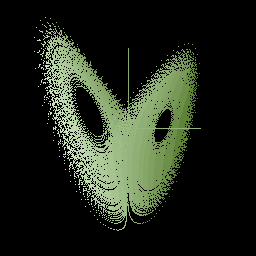| 1 | With reference to Lorentz's strange attractor the famous statement on chaos says that the flapping of a butterfly's wings in Tokyo can cause a tornado in Texas.
|
| 2 | Thus, a butterfly flapping its wings somewhere in Chicago may cause a tornado in Tokyo.
|
| 3 | In other words, the flutter of a butterfly's wings in China could, in fact, actually effect weather patterns in New York City, thousands of miles away.
|
| 4 | This is the cute little idea that a butterfly fluttering in Peking can cause storms to erupt in New York.
|
| 5 | Can a butterfly stirring the air of Naupli today can transform storms in New York the next day or three months later?
|
| 6 | The idea is that a butterfly flapping its wings in China could produce a tornado in Kansas.
|
| 7 | This means that a butterfly in Japan can effect the wheather in the world.
|
| 8 | The standard joke among chaologists is that a butterfly flapping its wings in the Amazon can influence a typhoon in the Pacific Ocean.
|
| 9 | A butterfly flapping its wings in Turkey could change tornado patterns in Texas
|
| 10 | This leads to the cliche that ``the flutter of a butterfly wing in Lima, Peru today can affect the weather in Toronto a month later.''
|
| 11 | This effect became known as the Butterfly Effect - a butterfly in the USA may cause changes in air turbulance that could significantly effect weather in Asia
|
| 12 | Dynamical instability is sometimes called "the butterfly effect": a butterfly flapping its wings in Brazil can cause a hurricane in Bengal.
|
| 13 | A butterfly in Seattle could disrupt the weather in Cincinnati.
|
| 14 | Edward Lorentz called this property the butterfly's effect, meaning that the butterfly moving its colourful wings over Peking in June can indirectly cause the disastrous hurricane over Argentina in September
|
| 15 | This is sometimes referred to as the butterfly effect, i.e. a butterfly flapping its wings in South America can affect the weather in Central Park
|
| 16 | The canonical example is the possibility of a butterfly's sneeze affecting the weather enough to cause a hurricane weeks later
|


